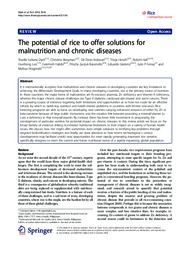The potential of rice to offer solutions for malnutrition and chronic diseases.
The potential of rice to offer solutions for malnutrition and chronic diseases.
Author(s): DIPTI, S. S.; BERGMAN, C.; INDRASARI, S. D.; HERATH, T.; HALL, R.; LEE, H.; HABIBI, F.; BASSINELLO, P. Z.; GRATEROL, E.; FERRAZ, J. P.; FITZGERALD, M.
Summary: It is internationally accepted that malnutrition and chronic diseases in developing countries are key limitations to achieving the Millennium Development Goals. In many developing countries, rice is the primary source of nutrition. In those countries, the major forms of malnutrition are Fe-induced anaemia, Zn deficiency and Vitamin A deficiency, whereas the major chronic disease challenges are Type II diabetes, cardiovascular disease and some cancers. There is a growing corpus of evidence regarding both limitations and opportunities as to how rice could be an effective vehicle by which to tackle key nutrition and health related problems in countries with limited resources. Rice breeding programs are able to focus on developing new varieties carrying enhanced amounts of either Fe, Zn or beta-carotene because of large public investment, and the intuitive link between providing a mineral/vitamin to cure a deficiency in that mineral/vitamin. By contrast, there has been little investment in progressing the development of particular varieties for potential impact on chronic diseases. In this review article we focus on the broad battery of evidence linking rice-related nutritional limitations to their impact on a variety of human health issues. We discuss how rice might offer sometimes even simple solutions to rectifying key problems through targeted biofortification strategies and finally, we draw attention to how recent technological (−omics) developments may facilitate untold new opportunities for more rapidly generating improved rice varieties specifically designed to meet the current and future nutritional needs of a rapidly expanding global population.
Publication year: 2012
Types of publication: Journal article
Unit: Embrapa Rice & Beans
Keywords: Arroz, Chronic diseases, Deficiencia nutricional, Malnutrition, Oryza sativa, Rice, Saude, Solutions, Valor nutritivo
Observation
Some of Embrapa's publications are published as ePub files. To read them, use or download one of the following free software options to your computer or mobile device. Android: Google Play Books; IOS: iBooks; Windows and Linux: Calibre.
Access other publications
Access the Agricultural Research Database (BDPA) to consult Embrapa's full library collection and records.
Visit Embrapa Bookstore to purchase books and other publications sold by Embrapa.

